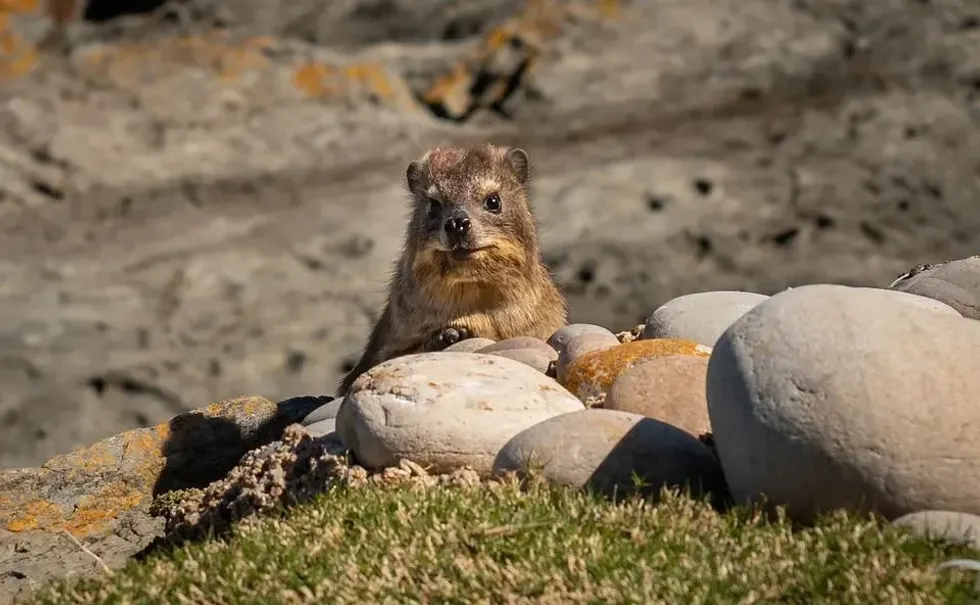What is a hyrax? Well, a hyrax animal (Procavia capensis) is a territorial animal usually found in Africa and the Middle East.
A rock hyrax can also be called a rock badger. This species looks like a cross between a rabbit and a woodchuck. This is why the sound made by the rock hyrax is more like a bird than a mammal.
Rock hyraxes sing in arranged sounds known as the syntax. This is the same way birds communicate.
They are medium-sized animals and usually live in rocky regions, and scrub-covered areas as escaping and hiding in the rocks are their best defense. The feet of a rock hyrax (Procavia capensis) are also fit for rocks.
They are bare and rubbery, which replicates a suction effect and gives them a good grip to walk on and under the rocks. Rock hyraxes are also very intelligent animals with long-term memory. Rock hyraxes feed in groups so as to keep an eye on predators and live in colonies.
Their diet comprises herbage, leaves, fruit, insects, lizards, and bird eggs. Though there is no direct threat to their existence, still efforts are on for their conservation in various countries.
A tree hyrax is different from a rock hyrax in the sense that a tree hyrax is a nocturnal animal while rocky hyraxes are active during the day. The rock hyraxes with their raised dorsal gland hair and retracted upper lip try to intimidate any intruders while the group is feeding.
Here are a few fun facts about the rock hyraxes (Procavia capensis). After you have read these fun facts, then do check out our articles on numbat and pademelon as well.
Rock Hyrax Interesting Facts
What type of animal is a rock hyrax?
A rock hyrax has different names like a rock rabbit and rock dassies. They are usually found in Africa and the Middle East. They prefer living in the rock regions as it is easier for them to hide from their attackers, like the leopard, big cats, and snakes.
They are medium-sized animals that look like rodents and belong to the class of mammals. They are brownish-grey in color and have a shade of cream on the underside with short ears.
The rock hyrax is a very intelligent animal with good long-term memory. They sound more like birds than mammals. Rock hyrax uses syntax in order to communicate.
What class of animal does a rock hyrax belong to?
A rock hyrax is also called rock dassies and rock rabbits. This species resemble rodents and belong to the class of mammals.
In scientific terms, the species is in the class Mammalia, order hyracoidea. Rock hyraxes are among the six species of the small hoofed mammals that are native to Africa and southwestern Asia. These African mammals have elephants and manatees as their closest relatives.
How many rock hyraxes are there in the world?
There is no distinct figure of the number of rock hyraxes in the world. However, the number of the species is annually increasing and are not extinct. As per rock hyrax definition, these animals are mainly found in rocky African regions.
Where does a rock hyrax live?
Rock hyrax prefers living in the rocky scrub-covered areas of Africa, Lebanon, Israel, Jordan, and the Arabian peninsulas. The hyrax’s feet are built for rock climbing. The bottom of each of their feet is bare and has a moist rubbery pad that replicates a suction effect giving the rocky hyrax a good grip.
What is a rock hyrax's habitat?
The habitat preferred by the rock hyraxes is an environment that is arid such as deserts, rocky terrains, scrub-covered areas, the savannas. These areas must have moderate vegetation as this species primarily feeds on greens and herbs.
The species prefers regions with abundant rock cavities. These cavities are used as shelters and places to hide by the rock hyrax in situations of danger.
Who do rock hyraxes live with?
Rock hyraxes are active during the day and at a time during the moon-lit night. They usually live in small groups, one male with several female and young animals.
Mature males usually are found to live alone. This group helps them protect themselves from their predators. They attach their small predators by biting, however escaping and hiding in the rocks is their best defense.
How long does a rock hyrax live?
The life span of a rock hyrax is approximately between 9-12 years.
How do they reproduce?
Rocky hyraxes are polygynous. Before the copulation, the dominant male calls the female and approaches the female.
Mating females may attack the approach if they are not willing to mate. A female backs into the male and presses her anogenital region against the male. The dominant male grasps her with his forelegs, and they stay in the position until the copulation period ends.
The female hyrax gestation period lasts somewhere around eight months. After completion of the gestation period the female gives birth to around one to four baby hyraxes.
What is their conservation status?
They are annually increasing and are found in the regions of Africa. Their conservation status is not extinct.
Rock Hyrax Fun facts
What do rock hyraxes look like?
A rock hyrax looks similar to rodent and belongs to the class of mammals. They look like a bigger version of a guinea pig with little hints of a rabbit. They have round ears and no tail.
They have stubby toes and have hoof-like nails. They have four toes on each front foot and three on each back foot. They have short straight coats with a lighter underbelly.
They are brownish-grey in color with a cream underbelly. They have extra long hair around their body called the guard hairs, which help the hyrax to feel its way.
They use it the same way a cat uses its whiskers. Their body color can vary between gray to dark brown. The dorsal gland can be surrounded by either yellow, black, or orange hair.
*We've been unable to source an image of a baiji dolphin and have used an image of a Chinese white dolphin instead. If you are able to provide us with a royalty-free image of a baiji dolphin, we would be happy to credit you. Please contact us at hello@kidadl.com.

How cute are they?
The tiny size of the rock hyrax makes it look very cute. They are like an oversized guinea pig, with whiskers around their body and stompy toes.
How do they communicate?
Hyraxes communicate via noises like squeals, snort whistles. They alert the fellow hyraxes with grunts, wails, growls, and shrieks. They also use syntax in order to communicate. This makes them sound more like birds than mammals.
How big is a rock hyrax?
A rock hyrax is a bigger version of a guinea pig. They are small-sized animals who weigh 10-20 lb. They have a body size of 12-22 in and can grow to a height between 8-12 in.
How fast can a rock hyrax run?
Their running speed depends on their size. Since they are small and fat species, a rock hyrax can run at a speed of 18 mph.
How much does a rock hyrax weigh?
A rock hyrax weighs approximately between 10-20 lb. However, this may vary depending on the vegetation around it.
What are their male and female names of the species?
They don't have distinct names based on sex. Generally the male is called male rock hyrax and the female is known as a female rock hyrax.
What would you call a baby rock hyrax?
They don't have a particular name for a baby rock hyrax.
What do they eat?
They primarily feed on the vegetation around them. They eat grasses, shrubs, herbs, fruits, seeds, small insects, and very rarely, lizards.
Are they aggressive?
They cannot be termed as very aggressive. However, rock hyraxes usually live in colonies that consist of small groups which are usually dominated by a single male. These males defend their territories and their fellow hyraxes from the rivals. In order to protect themselves, they sometimes indulge in biting their predators.
Would they make a good pet?
No, rock hyraxes are wild animals who prefer living in the arid, rocky regions or scrub-covered areas. A social environment is not their preferred habitat, and hence a rock hyrax should not be kept as a pet.
Did you know...
The light entering the hyraxes eye from above is decreased because of their protruding pupil.
They have hair similar to the whiskers of a cat. These tiny hair that are scattered across their body are an advantage to them.
They regulate their body temperature with the environment.
Their wide mouths with very sharp teeth allow them to eat quickly and hide incase of predators.
They are often found in male led colonies with around 2-26 hyraxes.
They are the nearest living cousins of elephants and the manatees and share many similarities with them. Their foot structures, the tusks, male testes and mammary glands are all similar.
Why do rock hyraxes have tusks?
Rock hyraxes look similar to rodents. They are the closest relatives to the elephants and the manatees. They have a long pair of tusks like incisors. Males usually have larger and sharper tusks as compared to females.
Is the rock hyrax in the Bible?
The rock hyrax, also called the dassie, was referenced in the Bible. These mammals native to Africa were called cony in the Bible.
Here at Kidadl, we have carefully created lots of interesting family-friendly animal facts for everyone to discover! Learn more about some other mammals including northern short-tailed shrew, or pygmy slow loris.
You can even occupy yourself at home by drawing one on our Rock Hyrax coloring pages.










